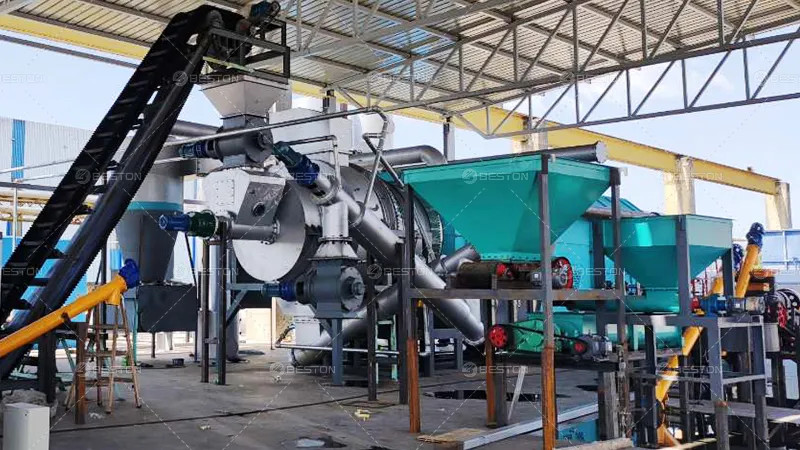Minimizing Harmful Emissions in Biomass Pyrolysis Plant
Biomass pyrolysis is an effective process for converting organic materials into valuable by-products such as bio-oil, gas, and char. However, like any industrial process, pyrolysis can generate harmful emissions if not properly managed. These emissions, including particulate matter, volatile organic compounds (VOCs), carbon monoxide, and greenhouse gases, can pose serious environmental and health risks. To ensure a cleaner and more sustainable operation, it is essential to implement strategies to minimize harmful emissions from biomass pyrolysis plant.
Optimizing Pyrolysis Temperature and Conditions
One of the most important factors influencing the types and quantities of emissions produced during biomass pyrolysis is the temperature and process conditions within the reactor. Pyrolysis typically occurs in a temperature range of 350°C to 700°C, where organic material decomposes in an oxygen-limited environment. At higher temperatures, the breakdown of biomass becomes more efficient, producing more desirable products like bio-oil and gas while reducing the formation of unwanted emissions.
However, higher temperatures can also lead to the production of more particulate matter and other pollutants. To mitigate this, precise control of the pyrolysis temperature is necessary. By maintaining an optimal range and gradually adjusting heating rates, the pyrolysis process can be fine-tuned to minimize the generation of harmful by-products, ensuring a more controlled and efficient conversion of biomass.

Implementing Gas Cleaning and Filtration Systems
A critical approach to reducing harmful emissions is the installation of gas cleaning and filtration systems within the biochar reactor. As the biomass decomposes, volatile gases are released, which can contain harmful substances such as tar, ash particles, and gaseous pollutants. These gases must be treated before being released into the atmosphere.
Advanced gas cleaning systems, such as cyclonic separators, scrubbers, and electrostatic precipitators, can capture particulate matter and reduce the emission of gases like carbon monoxide and methane. Cyclones help separate larger particles, while scrubbers use water or chemicals to wash away fine particulates and gases. Electrostatic precipitators use electrical charges to capture charged particles from the exhaust stream, significantly reducing particulate emissions.
By investing in these filtration systems, a biomass pyrolysis plant can operate more efficiently, with a much lower environmental impact.
Utilization of Condensation and Reformation Technologies
Another effective method for reducing harmful emissions is the use of condensation and reformation technologies. During pyrolysis, gases such as acetic acid, acetone, and methanol are produced. These gases can be harmful if not properly managed. One approach to minimizing their release into the atmosphere is through condensation, where gases are cooled and condensed into liquid forms that can be safely stored or processed further.
Additionally, advanced reforming technologies, such as catalytic reformers, can help convert these gases into more useful products or reduce their harmful properties. By employing such technologies, biomass pyrolysis plants can reduce emissions and increase the overall yield of valuable by-products, making the operation more sustainable and profitable.
Enhancing the Efficiency of Heat Recovery Systems
Efficient heat recovery is another critical aspect of reducing harmful emissions. Pyrolysis is an energy-intensive process, and without proper heat management, excess heat can lead to the production of unwanted gases. Implementing a heat recovery system, such as a heat exchanger or waste heat boiler, allows for the efficient capture and reuse of thermal energy from the exhaust gases. This reduces the need for additional fuel sources and minimizes the amount of waste heat released into the environment.
By utilizing heat recovery systems, biomass pyrolysis plants can operate more efficiently, reduce emissions, and lower their carbon footprint. These systems also improve overall energy efficiency, making the plant more sustainable in the long term.
Monitoring and Controlling Emissions with Advanced Sensors
Real-time monitoring and control of emissions play a vital role in minimizing harmful emissions from biomass pyrolysis plants. Installing advanced sensors throughout the plant allows operators to continuously monitor key parameters such as temperature, pressure, and gas composition. These sensors provide valuable data that can be used to adjust process conditions in real-time, preventing the formation of excessive pollutants.
Incorporating automated control systems based on sensor data enables operators to optimize the pyrolysis process for reduced emissions. For example, if elevated levels of carbon monoxide or particulate matter are detected, the system can automatically adjust the reactor temperature or activate filtration systems to reduce the output of harmful emissions. This proactive approach ensures that emissions remain within acceptable limits and helps avoid environmental violations.
Maintaining Proper Combustion Systems
Efficient combustion systems are critical to controlling emissions in biomass pyrolysis plants. Biomass-derived gases, particularly those generated during pyrolysis, must be combusted efficiently to minimize the release of harmful substances. The combustion process should be carefully monitored to ensure complete combustion, reducing the formation of carbon monoxide, nitrogen oxides, and other pollutants.
A well-maintained combustion system, including an afterburner or secondary combustion chamber, can help to further reduce harmful emissions by ensuring that any uncombusted gases from the pyrolysis process are fully oxidized before being released into the atmosphere. Regular inspections, cleaning, and maintenance of the combustion system are essential to keep emissions at a minimum.
Sustainable Feedstock Sourcing
The feedstock used in biomass pyrolysis also plays a crucial role in emissions. Feedstocks that are high in moisture or contain a significant amount of volatile organic compounds can increase the emission of pollutants during the pyrolysis process. To minimize these emissions, it is important to source feedstock that is dry and has a low moisture content.
In addition to moisture control, ensuring that the biomass is free from contaminants such as chemicals, plastics, or other non-organic materials can reduce the formation of harmful substances during pyrolysis. Sustainable sourcing practices, such as using agricultural residues, forestry by-products, or dedicated energy crops, can help reduce the environmental impact of the feedstock itself.